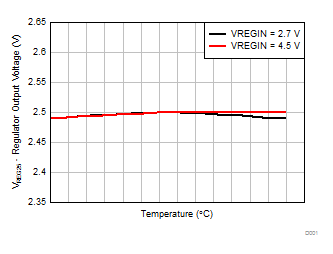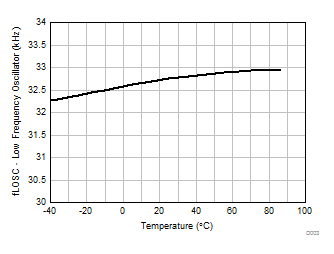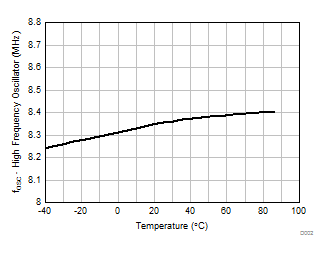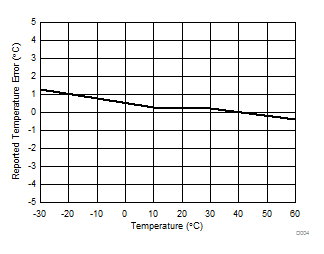SLUSB23B October 2012 – June 2015
PRODUCTION DATA.
- 1 Features
- 2 Applications
- 3 Description
- 4 Revision History
- 5 Device Comparison Table
- 6 Pin Configuration and Functions
-
7 Specifications
- 7.1 Absolute Maximum Ratings
- 7.2 ESD Ratings
- 7.3 Recommended Operating Conditions
- 7.4 Thermal Information
- 7.5 Electrical Characteristics: Power-On Reset
- 7.6 2.5-V LDO Regulator
- 7.7 Integrating ADC (Coulomb Counter) Characteristics
- 7.8 Integrated Sense Resistor Characteristics
- 7.9 ADC (Temperature and Cell Measurement) Characteristics
- 7.10 EEPROM Memory Characteristics
- 7.11 Timing Requirements: I2C-Compatible Interface Communication
- 7.12 Typical Characteristics
-
8 Detailed Description
- 8.1 Overview
- 8.2 Functional Block Diagram
- 8.3 Feature Description
- 8.4 Device Functional Modes
- 8.5
Programming
- 8.5.1
Standard Data Commands
- 8.5.1.1
Control(): 0x00 and 0x01
- 8.5.1.1.1 CONTROL_STATUS: 0x0000
- 8.5.1.1.2 DEVICE_TYPE: 0x0001
- 8.5.1.1.3 FW_VERSION: 0x0002
- 8.5.1.1.4 PREV_MACWRITE: 0x0007
- 8.5.1.1.5 CHEM_ID: 0x0008
- 8.5.1.1.6 BAT_INSERT: 0X000C
- 8.5.1.1.7 BAT_REMOVE: 0X000D
- 8.5.1.1.8 SET_HIBERNATE: 0x0011
- 8.5.1.1.9 CLEAR_HIBERNATE: 0x0012
- 8.5.1.1.10 SET_CFGUPDATE: 0x0013
- 8.5.1.1.11 SEALED: 0x0020
- 8.5.1.1.12 RESET: 0x0041
- 8.5.1.1.13 SOFT_RESET: 0x0042
- 8.5.1.2 Temperature( ): 0x02 and 0x03
- 8.5.1.3 Voltage( ): 0x04 and 0x05
- 8.5.1.4 Flags( ): 0x06 and 0x07
- 8.5.1.5 NominalAvailableCapacity( ): 0x08 and 0x09
- 8.5.1.6 FullAvailableCapacity( ): 0x0A and 0x0B
- 8.5.1.7 RemainingCapacity( ): 0x0C and 0x0D
- 8.5.1.8 FullChargeCapacity( ): 0x0E and 0x0F
- 8.5.1.9 AverageCurrent( ): 0x10 and 0x11
- 8.5.1.10 AveragePower( ): 0x18 and 0x19
- 8.5.1.11 StateOfCharge( ): 0x1C and 0x1D
- 8.5.1.12 IntTemperature( ): 0x1E and 0x1F
- 8.5.1.13 StateOfHealth( ): 0x20 and 0x21
- 8.5.1.14 OperationConfiguration( ): 0x3A and 0x3B
- 8.5.1.15 DesignCapacity( ): 0x3C and 0x3D
- 8.5.1.16 DebugX( ):
- 8.5.1.1
Control(): 0x00 and 0x01
- 8.5.2 Extended Data Commands
- 8.5.3 Block Data Interface
- 8.5.4 Access Modes
- 8.5.5 Data Block Summary
- 8.5.6 Detecting Charge Termination
- 8.5.7 Communications
- 8.5.1
Standard Data Commands
- 8.6 Register Maps
- 9 Application and Implementation
- 10Power Supply Recommendations
- 11Layout
- 12Device and Documentation Support
- 13Mechanical, Packaging, and Orderable Information
Package Options
Mechanical Data (Package|Pins)
- YZF|15
Thermal pad, mechanical data (Package|Pins)
Orderable Information
7 Specifications
7.1 Absolute Maximum Ratings
over operating free-air temperature range (unless otherwise noted)(1)| MIN | MAX | UNIT | ||
|---|---|---|---|---|
| VREGIN | Regulator input | –0.3 | 6 | V |
| VCC | Supply voltage | –0.3 | 2.75 | V |
| VIOD | Open-drain I/O pins (SDA, SCL, GPOUT) | –0.3 | 6 | V |
| VBAT | BAT input pin | –0.3 | 6 | V |
| VI | Input voltage to all other pins (SRX, BIN) | –0.3 | VCC + 0.3 | V |
| TA | Operating free-air temperature | –40 | 85 | °C |
| Tstg | Storage temperature | –65 | 150 | °C |
(1) Stresses beyond those listed under Absolute Maximum Ratings may cause permanent damage to the device. These are stress ratings only, and functional operation of the device at these or any other conditions beyond those indicated under Recommended Operating Conditions is not implied. Exposure to absolute-maximum-rated conditions for extended periods may affect device reliability.
7.2 ESD Ratings
| VALUE | UNIT | |||
|---|---|---|---|---|
| V(ESD) | Electrostatic discharge | Human body model (HBM), per ANSI/ESDA/JEDEC JS-001(1) | ±500 | V |
| Charged device model (CDM), per JEDEC specification JESD22-C101(2) | ±250 | |||
(1) JEDEC document JEP155 states that 500-V HBM allows safe manufacturing with a standard ESD control process.
(2) JEDEC document JEP157 states that 250-V CDM allows safe manufacturing with a standard ESD control process.
7.3 Recommended Operating Conditions
TA = 25°C and VREGIN = VBAT = 3.6 V (unless otherwise noted)| MIN | NOM | MAX | UNIT | |||
|---|---|---|---|---|---|---|
| VREGIN | Supply voltage | No operating restrictions | 2.8 | 4.5 | V | |
| No NVM writes | 2.45 | 2.8 | ||||
| CREGIN | External input capacitor for internal LDO between REGIN and VSS | Nominal capacitor values specified. Recommend a 5% ceramic X5R type capacitor located close to the device. | 0.1 | μF | ||
| CLDO25 | External output capacitor for internal LDO between VCC and VSS | 0.47 | 1 | μF | ||
| ICC | NORMAL operating-mode current(1) | Fuel gauge in NORMAL mode. ILOAD > Sleep Current |
118 | μA | ||
| ISLP | SLEEP mode operating mode current(1) | Fuel gauge in SLEEP mode. ILOAD < Sleep Current |
23 | μA | ||
| IHIB | HIBERNATE operating-mode current(1) | Fuel gauge in HIBERNATE mode. ILOAD < Hibernate Current |
8 | μA | ||
| ISHD | SHUTDOWN mode current(1) | Fuel gauge in SHUTDOWN mode. CE Pin < VIL(CE) maximum |
1 | μA | ||
| VOL(OD) | Output low voltage on open-drain pins (SCL, SDA, GPOUT) | IOL = 1 mA | 0.4 | V | ||
| VOH(OD) | Output high voltage on open-drain pins (SDA, SCL, GPOUT) | External pullup resistor connected to VCC | VCC – 0.5 | V | ||
| VIL | Input low voltage, all digital pins | 0.6 | V | |||
| VIH | Input high voltage (SDA, SCL) | 1.2 | V | |||
| Input high voltage (BIN) | 1.2 | |||||
| VA2 | Input voltage (BAT) | VSS – 0.125 | 5 | V | ||
| VA3 | Input voltage (SRX) (1)(2) | VSS – 0.04 | 0.04 | V | ||
| Ilkg | Input leakage current (I/O pins) | 0.3 | μA | |||
| tPUCD | Power-up communication delay | 250 | ms | |||
(1) Specified by design. Not production tested.
(2) Limited by ISRX maximum recommend input current with some margin for the Integrated Sense Resistor tolerance.
7.4 Thermal Information
over operating free-air temperature range (unless otherwise noted)| THERMAL METRIC(1) | bq27425-G2 | UNIT | |
|---|---|---|---|
| YZF [DSBGA] | |||
| 15 PINS | |||
| RθJA | Junction-to-ambient thermal resistance | 70 | °C/W |
| RθJCtop | Junction-to-case (top) thermal resistance | 17 | °C/W |
| RθJB | Junction-to-board thermal resistance | 20 | °C/W |
| ψJT | Junction-to-top characterization parameter | 1 | °C/W |
| ψJB | Junction-to-board characterization parameter | 18 | °C/W |
| RθJCbot | Junction-to-case (bottom) thermal resistance | n/a | °C/W |
(1) For more information about traditional and new thermal metrics, see the Semiconductor and IC Package Thermal Metrics application report, SPRA953
7.5 Electrical Characteristics: Power-On Reset
TA = –40°C to 85°C, typical values at TA = 25°C and VREGIN = 3.6 V (unless otherwise noted)| PARAMETER | TEST CONDITIONS | MIN | TYP | MAX | UNIT | |
|---|---|---|---|---|---|---|
| VIT+ | Positive-going voltage on VCC (Regulator output) | 1.98 | 2.20 | 2.31 | V | |
| VHYS | Power-on reset hysteresis | 43 | 115 | 185 | mV | |
7.6 2.5-V LDO Regulator
TA = –40°C to 85°C, CLDO25 = 1 μF, VREGIN = 3.6 V (unless otherwise noted)| PARAMETER | TEST CONDITION | MIN | NOM | MAX | UNIT | |
|---|---|---|---|---|---|---|
| VREG25 | Regulator output voltage | 2.7 V ≤ VREGIN ≤ 4.5 V, IOUT ≤ 5 mA | 2.4 | 2.5 | 2.6 | V |
| 2.45 V ≤ VREGIN < 2.7 V (low battery), IOUT ≤ 3 mA |
2.4 | |||||
| VIH(CE) | CE High-level input voltage | VREGIN = 2.7 to 4.5 V | 2.65 | V | ||
| VIL(CE) | CE Low-level input voltage | 0.8 | ||||
7.7 Integrating ADC (Coulomb Counter) Characteristics
TA = –40°C to 85°C; typical values at TA = 25°C and VREGIN = 3.6 V (unless otherwise noted)| PARAMETER | TEST CONDITIONS | MIN | TYP | MAX | UNIT | |
|---|---|---|---|---|---|---|
| VSR | Input voltage (1)(2) | VSR = V(SRX) – VSS | –0.04 | 0.04 | V | |
| tSR_CONV | Conversion time | Single conversion | 1 | s | ||
| Resolution | 14 | 15 | bits | |||
| VOS(SR) | Input offset | 10 | μV | |||
| INL | Integral nonlinearity error | ±0.007 | ±0.034 | % FSR | ||
| ZIN(SR) | Effective input resistance(1) | 2.5 | MΩ | |||
| Ilkg(SR) | Input leakage current(1) | TA = 25°C | 0.3 | μA | ||
(1) Specified by design. Not tested in production.
(2) Limited by ISRX maximum recommend input current with some margin for the Integrated Sense Resistor tolerance.
7.8 Integrated Sense Resistor Characteristics
TA = –40°C to 85°C; typical values at TA = 25°C and VREGIN = 3.6 V (unless otherwise noted)| PARAMETER | TEST CONDITIONS | MIN | TYP | MAX | UNIT | |
|---|---|---|---|---|---|---|
| SRXRES | Resistance of Integrated Sense Resistor from SRX to VSS(1)(2) | TA = 25°C | 10 | mΩ | ||
| ISRX | Recommended Sense Resistor input current(1)(3) | Long term RMS, average device utilization. | 2000 | mA | ||
| Peak RMS current, 10% device utilization.(3) | 2500 | mA | ||||
| Peak pulsed current, 250 ms maximum, 1% device utilization.(3) | 3500 | mA | ||||
(1) Specified by design. Not tested in production.
(2) Firmware compensation applied for temperature coefficient of resistor.
(3) Device utilization is the long term usage profile at a specific condition compared to the average condition.
7.9 ADC (Temperature and Cell Measurement) Characteristics
TA = –40°C to 85°C; typical values at TA = 25°C and VREGIN = 3.6 V (unless otherwise noted)| PARAMETER | TEST CONDITIONS | MIN | TYP | MAX | UNIT | |
|---|---|---|---|---|---|---|
| VIN(ADC) | Input voltage | 0.05 | 1 | V | ||
| GTEMP | Temperature sensor voltage gain | –2 | mV/°C | |||
| tADC_CONV | Conversion time | 125 | ms | |||
| Resolution | 14 | 15 | bits | |||
| VOS(ADC) | Input offset | 1 | mV | |||
| ZADC | Effective input resistance (BAT)(1) | Not measuring cell voltage | 8 | MΩ | ||
| Measuring cell voltage | 100 | kΩ | ||||
| Ilkg(ADC) | Input leakage current(1) | TA = 25°C | 0.3 | μA | ||
(1) Specified by design. Not tested in production.
7.10 EEPROM Memory Characteristics
TA = –40°C to 85°C; typical values at TA = 25°C and VREGIN = 3.6 V (unless otherwise noted)| PARAMETER | TEST CONDITIONS | MIN | TYP | MAX | UNIT | |
|---|---|---|---|---|---|---|
| Array Size | 256 | bytes | ||||
| Data retention(1) | 10 | years | ||||
| Programming write cycles(1) | 100K | cycles | ||||
(1) Specified by design. Not production tested
7.11 Timing Requirements: I2C-Compatible Interface Communication
TA = –40°C to 85°C; typical values at TA = 25°C and VREGIN = 3.6 V (unless otherwise noted)| MIN | NOM | MAX | UNIT | ||
|---|---|---|---|---|---|
| tr | SCL or SDA rise time | 300 | ns | ||
| tf | SCL or SDA fall time | 300 | ns | ||
| tw(H) | SCL pulse duration (high) | 600 | ns | ||
| tw(L) | SCL pulse duration (low) | 1.3 | μs | ||
| tsu(STA) | Setup for repeated start | 600 | ns | ||
| td(STA) | Start to first falling edge of SCL | 600 | ns | ||
| tsu(DAT) | Data setup time | 100 | ns | ||
| th(DAT) | Data hold time | 0 | ns | ||
| tsu(STOP) | Setup time for stop | 600 | ns | ||
| t(BUF) | Bus free time between stop and start | 66 | μs | ||
| fSCL | Clock frequency(1) | 400 | kHz | ||
(1) If the clock frequency (fSCL) is > 100 kHz, use 1-byte write commands for proper operation. All other transactions types are supported at 400 kHz. (See I2C Interface and I2C Command Waiting Time)
 Figure 1. I2C-Compatible Interface Timing Diagrams
Figure 1. I2C-Compatible Interface Timing Diagrams
7.12 Typical Characteristics



